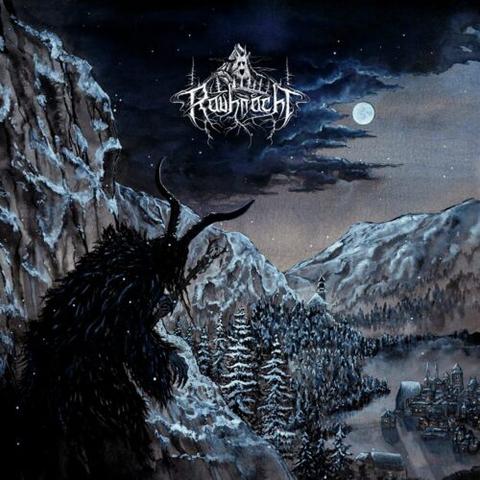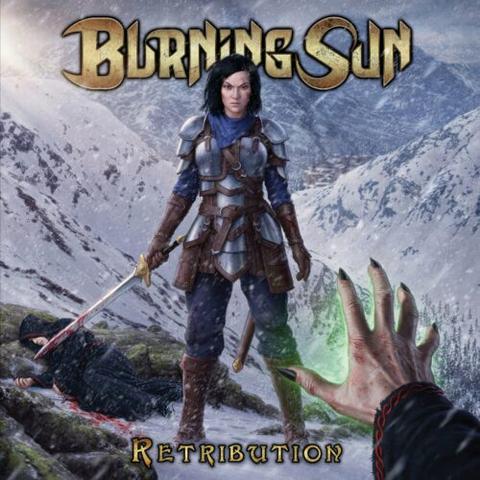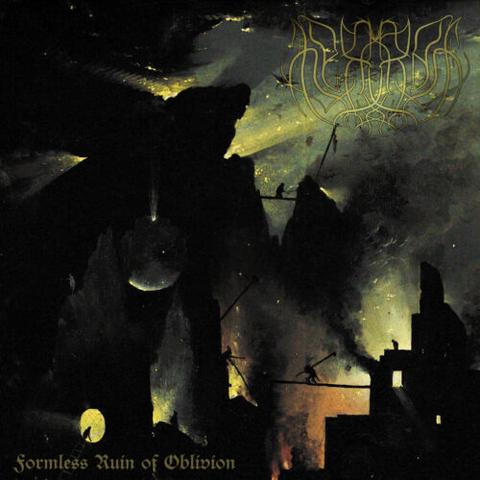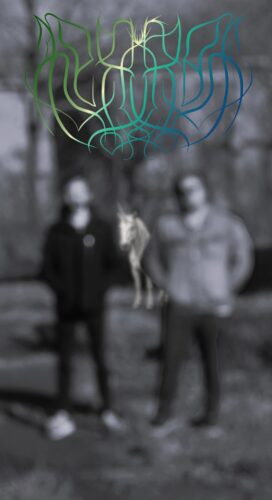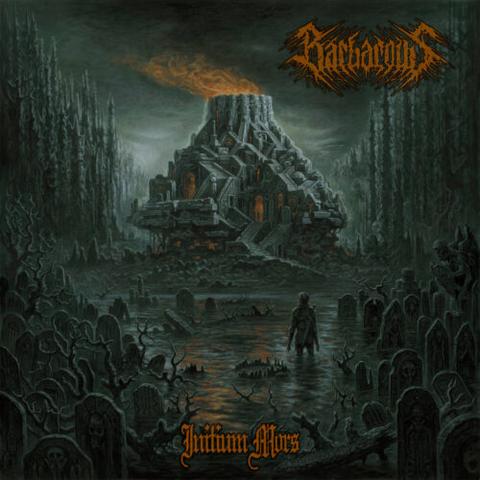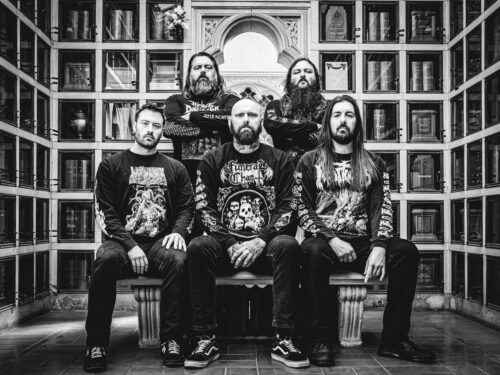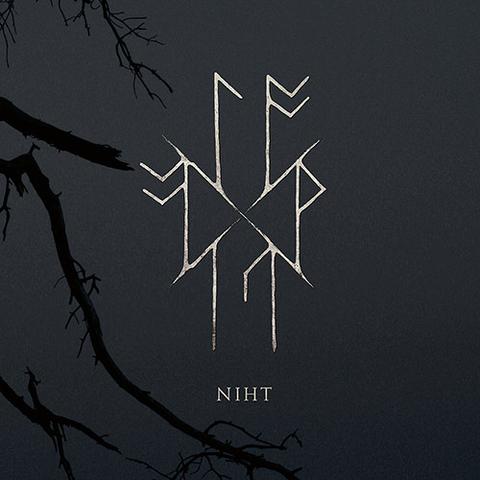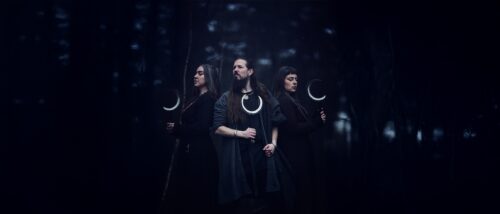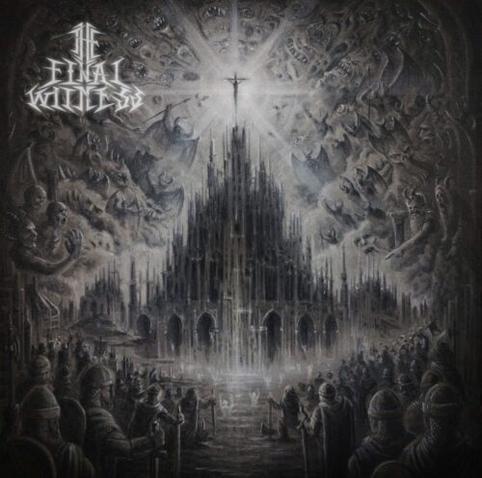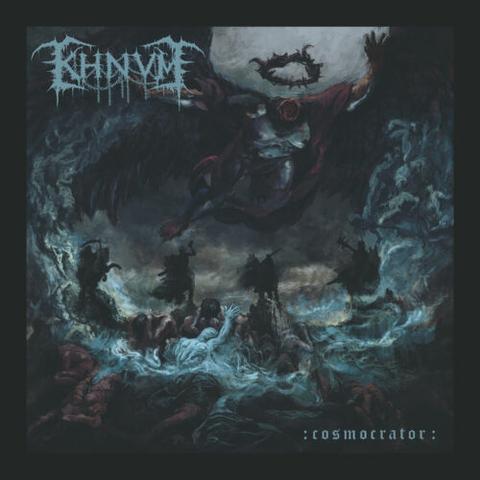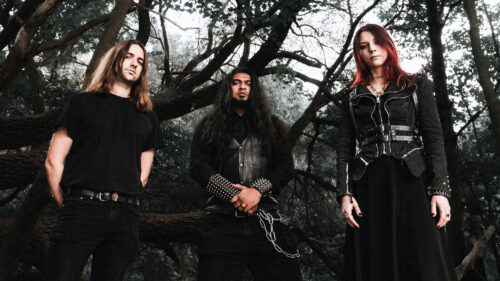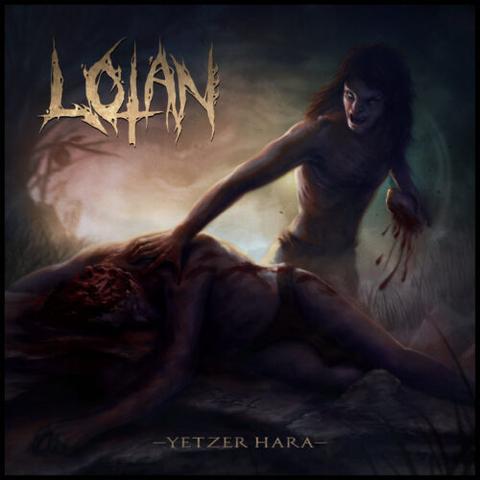Stuck in the Filter: August 2025’s Angry Misses
By Kenstrosity
The heat persists, but now the humidity comes in full force as storm systems wreak havoc upon the coasts. I hide in my cramped closet of an office, lest I be washed out once again by an unsuspecting deluge. However, I still send my minions out into the facility, bound by duty to search for those metallic scraps on which we feast.
Fortuitously, most all of those imps I sent out came back alive, and with wares! BEHOLD!
Kenstrosity’s Galactic Gremlin
Silent Millenia // Celestial Twilight: Beyond the Crimson Veil [August 26th, 2025 – Self-Release]
Have you ever seen such a delightfully cheesy cover? Probably, but it’s been a while for me. I bought Celestial Twilight: Beyond the Crimson Veil, the second raw symphonic black metal opus from Finnish one-man act Silent Millenia, on the strength of the artwork alone. Little did I know that what lay beyond this crimson veil was some of the most fun melodic black metal this side of Moonlight Sorcery. The same low-fi roughness that personifies Old Nick’s work grounds Silent Millenia’s starbound songwriting as it traverses the universe with an energetic punch reminiscent of Emperor or Stormkeep (“Awaken the Celestial Spell,” “Daemonic Mastery”). To help differentiate Silent Millenia’s sound from that of their peers, a gothic atmosphere ensorcells much of this material to great effect, merging eerie Victorian melodies with galactic adventurism in an unlikely pair (“Enthrone the Spectral”). Swirling synths and sparkling twinkles abound as well, creating blissful moments of interest as frosty tremolos and piercing blasts take full advantage of the false sense of security those entrancing clouds of synthetic instrumentation create (“Benighted Path to Darkness Mysterium,” “Reign in Cosmic Majesty”). Simply put, Celestial Twilight is an unexpected gem of a symphonic black metal record, bursting with killer ideas and infinite levels of raw, unabashed fun. You should hear it!
Kronos’ Unexpected Unearthments
Street Sects // Dry Drunk [August 15th, 2025 – Self Release]
Dry Drunk sticks to your inner surfaces, draining down like cigarette tar along paralyzed cilia to pool in your lungs until the cells themselves foment rebellion. Once it’s in you, you feel paranoid, wretched, and alone. So it’s the proper follow-up to Street Sects’ visionary debut, End Position. Like that record, Dry Drunk plumbs the most mundane and unsavory gutters of America for a cast of protagonists that it dwells in or dispatches with a mixture of pity and disgust, with vocalist Leo Ashline narrating their violent crimes and self-hatred in a mixture of croons, shrieks, and snarls that cook the air before the speakers into the scent of booze and rotten teeth. And like that record, Shaun Ringsmuth (Glassing) dresses the sets with a fractal litter of snaps, squeals, crashes, gunshots, and grinding electronics, caked in tar and collapsing just as soon as it is swept into a structure. And like End Position, Dry Drunk is a masterpiece. The impeccable six-song stretch from “Love Makes You Fat” through “Riding the Clock” ties you to the bumper and drags you along some of the duo’s most creative side-roads, through the simmering, straightjacketed sludge of “Baker Act” to the chopped-up, smirking electronica of “Eject Button.” Swerving between addled, unintelligible agony and unforgettable anthems, Dry Drunk, like End Position before it is nothing less than the life of a junkie scraped together, heated on a spoon, and injected into your head. Once you’ve taken a hit, you will never be quite the same.
Thus Spoke’s Frightening Fragments
Defacement // Doomed [August 22nd, 2025 – Self Release]
There’s music for every vibe.1 The one Defacement fits is an exclusively extreme metal flavor of moody that is only appreciable by genre fans, made tangibly more eerie by their persistent idiosyncratic use of dark ambient interludes amidst the viciously distorted blackened death. Audiences—and reviewers—tend to disparage these electronic segments, but I’ve always felt their crackling presence increases the analog horror of it all, and rather than being a breather from the intensity, they prolong the nausea, the sense of emptiness, and the abject fearfulness of head-based trauma. This latter concept grows more metaphorical still on Doomed, where the violence is inside the mind, purpose-erasing, and emotionally-detaching. The ambience might be the most sadly beautiful so far (“Mournful,” and “Clouded” especially), and the transitions into nightmarish heaviness arguably the most fluid. And the metal is undoubtedly the most ambitious, dynamic, and magnificent of Defacement’s career, combining their most gruesome dissonance (“Portrait”) with their most bizarrely exuberant guitar melodies (“Unexplainable,” “Unrecognised”). Solos drip tangibly with (emotional) resonance (“Unexplainable,” “Absent”) and there’s not a breath or a moment of wasted space. Yes, the band’s heavier side can suffer from a nagging sense of homogeneous mass, but it remains transporting. While I can appreciate why others do not appreciate Defacement, this is the first of their outings I can truthfully say mesmerised me on first listen.
ClarkKent’s Heated Hymns
Phantom Fire // Phantom Fire [August 8th, 2025 – Edged Circle Productions]
While I waded through the murky depths of the August promo sump, Steel implored me to take the eponymous third album from Phantom Fire. “The AMG commentariat love blackened heavy metal,” he said. I disregarded his advice at my peril, and while I ended up enjoying what I grabbed, it turns out this would have been solid too. Featuring members from Enslaved, Kraków. Hellbutcher, and Aeternus, Phantom Fire play old school speed metal that harks back to the likes of Motörhead and Iron Maiden’s Killers. Thanks to healthy doses of bass and production values that allow the instruments to shine, each song is infused with energetic grooves. The music sounds fresh, crisp, and clear, from the booming drums to Eld’s “blackened” snarls. Early tracks “Eternal Void” and “All For None” show off the catchy blend of simple guitar riffs and a hoppin’ bass accompanied by energetic kit work. While placing a somewhat lengthy instrumental track in the middle of a record usually slows it down, “Fatal Attraction” turns out to be a highlight. It tells a tragic love story involving a motorcycle with nothing but instruments, an engine revving, and some police sirens. The second half of Phantom Fire gets a bit on the weirder side, turning to some stoner and psychedelia. There’s a push and pull between the stoner and Motörhead speed stuff on songs like “Malphas” and “Submersible Pt. 2,” and this blend actually works pretty well. It turns out that they aren’t phantom after all—these guys are truly fire.
Burning Witches // Inquisition [August 22nd, 2025 – Napalm Records]
With six albums in eight years, Swiss quintet Burning Witches has really been burning rubber. While such prolific output in such a short time frame generally spells trouble, Inquisition is a solid piece of heavy/power metal. Burning Witches dabbles in a mix of speedy power metal and mid-tempo heavy metal, often sounding like ’80s stalwarts Judas Priest and Def Leppard. With Laura Guldemond’s gruff voice, they produce a more weighty, less happy version of power metal than the likes of Fellowship or Frozen Crown. While the songs stick to formulaic structures, tempo shifts from song to song help keep things from growing stale. We see this variety right from the get-go, where “Soul Eater” takes a high-energy approach before moving into the more mellow “Shame.” There’s even a pretty solid ballad, “Release Me,” that grounds the back half of the record. Songs of the sort that Burning Witches write need catchy choruses, and fortunately, they deliver. “High Priestess of the Night” is a particular standout, delivering a knock-out punch in its delivery. It helps that the instrumental parts are well-executed, from crunchy riffs to subdued solos to booming blast beats. Anyone looking for a solid bit of power metal that’s not too heavy on the cheese will find this worth a listen.
Deathhammer // Crimson Dawn [August 29th, 2025 – Hells Headbangers Records]
Celebrating 20 years of blackened speed, Deathhammer drop LP number six with the kind of energy that exhausted parents dread to see in their children at bedtime. This is my first foray with the band, and I am in awe of the relentless level of manic energy they keep throughout Crimson Dawn’s 39 minutes. If science could learn how to harness their energy, we’d have an endless source of renewables. The two-piece out of Norway channels classic Slayer on crack and even has moments reminiscent of Painkiller-era Judas Priest. They play non-stop thrash cranked to 11, with persistent blast beats and some dual guitar parts that leave your head spinning from the rapid-fire directions the riffs fire off in. The heart of the mania is singer Sergeant Salsten. His crazed vocals are amazing—snarling, shouting, and shrieking in a way that took me back to the manic pitch Judge Doom could reach in Who Framed Roger Rabbit? He sings so fast that on the chorus of “Crimson Dawn,” it sounds like he says “Griffindor,” which had me searching confusedly for the Harry Potter tag. This was probably my favorite song, not just because of the Griffindor thing, but because that chorus is so catchy. Either way, it’s tough to pick a standout track because they all grip you by the throat and don’t let go. Crimson Dawn is a ton of fun and a must listen if you like your music fast.
Grin Reaper’s Bountiful Blight
Kallias // Digital Plague [August 14th, 2025 – Self Release]
Machine gun drumming, spacey synths, Morbid Angel-meets-Meshuggah riffing, Turian-esque barking and Voyager-reminiscent vocal melodies…what the fuck is going on here? The only thing more surprising than someone having the moxie to blend all these things together is how well they work in concert. Kallias doesn’t hold back on sophomore album Digital Plague, and the result is a rocket-fueled blast through forty-four minutes of eclectic, addictive prog. The mishmash of styles keeps the album fresh and unpredictable while never dipping its toes in inconsistent waters, and staccato rhythms propel listeners through eight tracks without losing steam. As with any prog metal worth its salt, Kallias brandishes technical prowess, and their cohesion belies the relatively short time they’ve been putting out music.2 The mix is well-suited to spotlight whoever needs it at a given time, whether the bass is purring (“Exogíini Kyriarchía”), the drums are being annihilated (“Pyrrhic Victory”), or a guitar solo nears Pettrucian wankery (“Phenomenal in Theory”). The end result is three-quarters of an hour filled with myriad influences that fuse into a sound all Kallias’s own, and it’s one I’ve returned to several times since discovering (also, credit to MontDoom for his stunning artwork, which helped initially draw my attention). Check it out—you’ll be sick if you avoid this one like the Plague.
Luke’s Kaleidoscopic Kicks
Giant Haze // Cosmic Mother [August 22nd, 2025 – Tonzonen Records]
Whereas many of my colleagues are bracing themselves for cooler conditions and harsh winters to come, in my neck of the woods, things are warming up. While my own wintry August filter proved scarce, there was one particular summery gem to lift moods with burly riffs and fat stoner grooves. Unheralded German act Giant Haze seemingly emerged out of nowhere during a random Bandcamp deep dive. Debut LP Cosmic Mother channels the good old days of ’90s-inspired desert rock, featuring grungy, doomy vibes via a groovy batch of riff-centric, hard-rocking and uplifting jams, evoking the nostalgic spirit of Kyuss, Fu Manchu, Clutch and perhaps even a dash of Danzig. Punching out raucous, groove-soaked hard rockers with skyscraping hooks (“Geographic Gardens Suck,” “King of Tomorrow,” “Panic to Ride”), summery, funk–psych jams (“Sunrise”), and bluesy, punk-infused fireballs (“Crank in Public,” “Shrink Age”) Giant Haze get a lot of things right on this assured debut. The songwriting is deceptively diverse and punchy, bolstered by solid production, tight musicianship, and the swaggering, ever so slightly goofy vocal charms and powerful hooks of frontman Christoph Wollmann. Inevitably, a few rough spots appear, but overall Cosmic Mother showcases oodles of budding potential, an impactful delivery, cheeky sense of humor, and infectious, feel-good songcraft.
Spicie Forrest’s Foraged Fruit
Bask // The Turning [August 22nd, 2025 – Season of Mist]
Last seen in 2019, Bask returns with fourth LP, The Turning, a concept album following The Rider as she and The Traveler traverse the stars. They still peddle the unique blend of stoner rock and Americana Kenstrosity reviewed favorably in 2019, but 2025 sees them looking up for inspiration. The Turning incorporates a distinct cosmic bent (“The Traveler,” “The Turning”) and post-rock structures (“Dig My Heels,” “Unwound”). These augmentations to Bask’s core sound are enhanced by the masterful pedal steel of new official member Jed Willis. Whether floating through the firmament or tilling earthly pastures, Willis creates textures both fresh and intensely nostalgic. The infinite shifting vistas of The Turning’s front half coalesce into singular timeless visions on the back half, supporting its conceptual nature in both content and form. Like a combination of Huntsmen and Somali Yacht Club, Bask weaves riffs and melodies heard across the plains and through the void above with an unguarded authenticity felt in your soul.
Dolphin Whisperer’s Disseminating Discharge
Plasmodulated // An Ocean ov Putrid, Stinky, Vile, Disgusting Hell [August 1st, 2025 – Personal Records]
Stinky, sticky, slimy—all adjectives that define the ideal death metal platter. Myk Colby has been trying to chase this perfect balance in a reverb-wonky package with projects like the d-beaten Hot Graves and extra hazy Wharflurch, but vile death metal balance is hard to achieve. However, An Ocean ov Putrid, Stinky, Vile, Disgusting Hell contains a recklessly pinched Demilichian riffage, classic piercing whammy bombs, and spook-minded synth ambience that places Plasmodulated with an odor more pungent than its peers. With an infected ear that festers equally with doom-loaded, Incantation-indebted drags (“Gelatinous Mutation ov Brewed Origin,” “Trapped in the Plasmovoid”) and Voivod-on-jenkem cutaways to foul-throated extravagence (“The Final Fuckening”). An air of intelligent tempo design keeps An Ocean from never feeling trapped in a maze of its own fumes, with Colby’s lush and bubbling synth design seguing tumbles into hammering deathly tremolo runs (“Such Rapid Sphacelation”) and Celtic Frosted riff tumbles (“Drowning in Sputum”) alike, all before swirling about his own tattered, trailing vocal sputters. Steady but slippery, elegant yet effluvial, An Ocean ov Putrid, Stinky, Vile, Disgusting Hell provides the necessary noxious pressure to corrode death metal-loving denizens into pure gloops of stained-denim pit worship. Delivered as labeled, Plasmodulated earns its hazardous declaration. We here at AMG are not liable for any OSHA violations that occur as a result of Plasmodulated consumption on the job, though.
#2025 #Aeternus #AmericanMetal #Americana #AnOceanOvPutridStinkyVileDisgustingHell #Aug25 #Bask #BlackMetal #BlackenedDeathMetal #BurningWitches #CelestialTwilightBeyondTheCrimsonVeil #CelticFrost #Clutch #CosmicMother #CrimsonDawn #Danzig #DarkAmbient #DeathMetal #Deathhammer #DefLeppard #Defacement #Demilich #DigitalPlague #Doomed #DryDrunk #DutchMetal #EdgedCircleProductions #Emperor #Enslaved #Fellship #FinnishMetal #FrozenCrown #FuManchu #GermanMetal #GiantHaze #Glassing #Hardcore #HeavyMetal #Hellbutcher #HellsHeadbangersRecords #HotGraves #Huntsmen #Incantation #Inquisition #IronMaiden #JudasPriest #Kallias #Kraków #Kyuss #MelodicBlackMetal #Meshuggah #MoonlightSorcery #MorbidAngel #Motörhead #NapalmRecords #NorwegianMetal #OldNick #PersonalRecords #PhantomFire #Plasmodulated #PowerMetal #ProgressiveDeathMetal #RawBlackMetal #Review #Reviews #SelfRelease #SilentMillenia #Slayer #Sludge #SludgeMetal #SomaliYachtClub #SpeedMetal #StonerRock #Stormkeep #StreetSects #StuckInTheFilter #StuckInTheFilter2025 #SwissMetal #SymphonicBlackMetal #TechnicalDeathMetal #TheTurning #TonzonenRecords #Turian #Voivod #Voyager #Wharflurch



